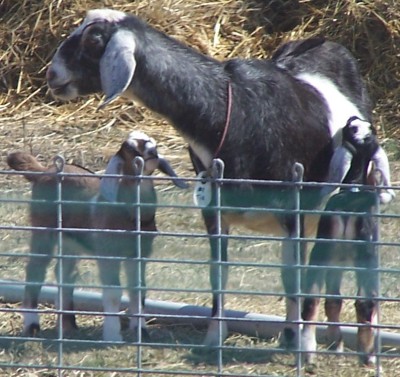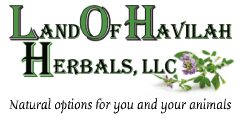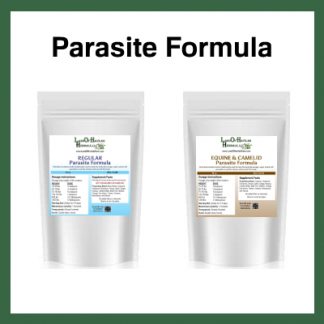Our Doe herd in their 7-acre pasture, which includes grassland with lots of browse and woods – a goat’s paradise!
(Left to right) SG Land of Havilah Sonador 1*M; Land of Havilah LSG Tipharah 3*M; SG Land of Havilah DreamOfLiberty 2*M; SG Land of Havilah ShekinahGlory 2*M; Land of Havilah LDG Eowyn; Land of Havilah LDG Arwen; *B Land of Havilah LDG Mithrander; *B Land of Havilah LG Ellesar; *B Land of Havilah LG Aragorn; *B Land of Havilah SSG Faramir; Land of Havilah LG DiamondGirl 2*M; and SG Lynnhaven SAH Galathea 1*M. Picture taken March 3rd, 2011
Dam raising AND giving a bottle. YES, it can be done! I do this for each of the kids born here. On the day they are born, before they nurse their momma, I milk some colostrum into a bottle and then give it directly to the goat kid. They learn to take the bottle, I can see how much colostrum they consume. I DO NOT strictly feed them with the bottle that first day. I also help them latch onto their Dam. I give them the required amount of colostrum from the bottle, plus a bonus of any additional colostrum that they nurse from their dam.
This works out very nicely, as I have my herd on DHIR (official Milk Test), and I have to separate the kids from their dam the WHOLE DAY while on test. They remember how to take a bottle from the first day of their life – smart little things!

Lynnhaven SAH Galathea 1*M enjoying the pleasure of raising her 2011 kids: Land of Havilah LG Ellesar (left) and Land of Havilah LG Aragorn (right). We insist on dam raising our goat kids for 8 weeks before allowing them to leave for their new home. This gets them off to a strong start and gives them a firm foundation to build on for a long, healthy life. Picture taken March 3rd, 2011.
Dam Raising. I strongly suggest that you test your goats for CAE, CL, Johne’s and Brucella before you, your family, OR your goat kids drink raw milk. See my “Blood Testing” section for further details. That being said, when you make the decision to dam raise, it DOES NOT mean that you don’t have to think about feeding those goat kids. Some of them have a very difficult time either FINDING the teats in the first place, AND/OR latching on to the teat. Some of my Does have teats that are BIG and AWESOME for milking, however, this type of teat DOES NOT reside where the goat kids expect to find them. You have to teach the kids to look LOWER then they naturally would. A tip: don’t try to push the kid’s head to force him/her in a certain direction to latch on – they will resist you. Try to guide them in the correct direction, cover their eyes (which will cause them to instinctively raise their nose and look for a teat). With your other hand reaching behind the Doe, take your finger and push the teat toward the kid’s mouth. If you try to just grab the teat and try to hold it for the kids to nurse, they seem to always get preoccupied trying to nurse from knuckle/finger/etc. You need to go out on a bottle feeding schedule to check on your goat kids and help them to latch on and get a full belly. I go out about every 4 hours to do this. Some kids take longer to learn than others, just keep going out on this schedule until one day when you make your appearance – low and behold! – momma’s udder is NOT full and the kid’s tummy IS!!! YAY!!! BTW, I don’t generally go out during the night. I make sure they latch on and get full tummies just before I go to bed, and then I make sure I go out there fairly early the next morning.
Milking Momma. The first 2-4 weeks, the kids are with their Dam 24/7, which give them full access to milk whenever they desire. HOWEVER, I check her udder EVERY 12 hours to make sure they are keeping her empty. If they are not, then I milk her out.
After the kids are 2-4 weeks old, I start separating the kids at night, so that I can milk their momma in the morning. I give a range, as it all depends on how many kids she had, and how much milk she is producing. Many times, my girls are producing so well that I can leave the kids 24/7 and I can STILL milk her and get quite a bit for us.
Coccidia. I use Land of Havilah Parasite Formula to deter coccidia. Starting within the first week after birth, I add it to their bottle (or put a pinch in their mouth) 3 days a week in dry weather. If the conditions are wet, I add it to their bottle on that day as well. Only ONE dose on each of those days.
Parasite management for goat kids.
You need to start addressing parasites within the first week of their life.
You need to start addressing parasites in kids as soon as they start “Sampling” dirt, etc on the ground. Around my farm, this happens when they are around one week old. THIS is when they pick up parasites. I start our parasite program with them three times per week at this point. I use Land of Havilah Parasite Formula for my goats at ALL stages of their life – even when they are pregnant. Kids get a pinch (or more, go by their weight) of this once a day 3x a week (specifically, Monday, Wednesday and Friday). If it rains or the ground is wet – they get it on those days too – that is PRIME breeding ground for coccidia! You CAN lamb bar this, put it in their bottle, or just put a pinch into their mouth.
Dam Raising Friendly Kids. People think that if you dam raise the kids they will be wild as a March hare. This is not the case with our kids. We spend time with them each day. I also give a bottle each day, but they were just as friendly before I started the DHIR program. The trick is to pick them up and pet them and spend time with them each day. Allow the new kids to watch you play with and pet the older kids. 🙂 “Monkey see, Monkey do.”
Free Choice Kelp. It is very important to provide kelp to the kids each day. Make sure they can reach the mineral feeders you keep the kelp in. I see mine eat it frequently. See the “Goat Minerals” section for more info.
Vaccinations? NO! I absolutely and positively WILL NOT give vaccinations to my goat kids, or any other animals on my farm for that matter. I strongly believe that they are DETRIMENTAL to their health and actually cause them to be MORE susceptible to disease. I cover this in greater detail under the “LOH Herd Health Practices“ Section. Keep in mind that I DO support their health in herbal & natural ways. DO NOT suggest or imply doing nothing to support them. If you choose not to vaccinate, do your homework and support their immune system properly.
Disbudding. I DO disbud the goat kids at 1-5 days old. I have a Rhinehart X50, which does a fantastic job! I keep a small container of Dr. Christopher’s Infection Formula (2013) near me and apply it to each side after I have disbudded that side – this protects against Tetanus. After I’m done with the entire procedure, I give the kid a drop or two of Cayenne/Lobelia Tincture, which helps them deal with shock. Poor babies! I hate disbudding, but it needs to be done. They get over it very quickly, and the Cayenne/Lobelia Tincture perks them up very quickly.
Tattooing. This is another job I don’t like. I tattoo each kid born on our farm, whether or not they are to be registered. This can be used identify them later, if need be. Their tattoo also appears on their registration papers. Please don’t use the white tattoo ink, in my experience, it fades or doesn’t turn out at all. I’ve gotten excellent results using green ink though. 😉
Tracking their Weight. This is something I started doing this year (2011). I weigh them each week (or thereabouts) to make sure they are gaining/growing properly. I find this is extremely helpful when dealing with multiples (3 or more kids) that are being dam raised. You need to make sure that all the kids are getting enough to eat in that situation, so if you weigh them each week you will catch a potential problem very early on. I want them to gain at least 10# per month OVER the amount they weighed at birth. For instance, if a kid was born at 9#, I would expect him/her to weigh 19# at one month old.
Did I forget to mention something that “curious minds want to know”? Please feel free to email me to ask. Many times I add that info to my pages. 😉



